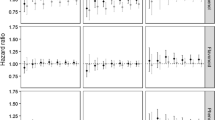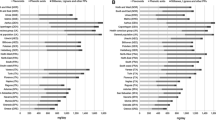Abstract
Studies of the association between polyphenols dietary intake and breast cancer risk have been limited due to the lack of detailed food composition tables. In addition, none has examined this association according to alcohol intake, despite the facts that alcohol is an established risk factor for breast cancer and that the contribution of alcoholic beverages to polyphenol intake varies according to the level of alcohol consumption. Our objectives were (1) to estimate the associations between breast cancer risk and a wide range of dietary polyphenols using the recently published Phenol-Explorer database; and (2) to evaluate if/how alcohol intake modulates these relationships. 4,141 women from the SU.VI.MAX prospective cohort were followed from 1994 to 2007 (median followup: 12.6 years); 152 developed a first incident invasive primary breast cancer. Dietary intakes were assessed by repeated 24-h records. The Phenol-Explorer database was used to estimate polyphenol intake. Multivariable Cox proportional hazards models were used to calculate hazard ratios (HRs) and 95 % confidence intervals (CIs) for quartiles of polyphenol intake. Analyses were stratified by median alcohol intake (< vs. ≥6.5 g/d). In non-to-low alcohol drinkers, intakes of some classes of polyphenols were associated with decreased breast cancer risk: hydroxybenzoic acids (HRQ4vsQ1 = 0.38, 95 % CI: 0.17–0.86, P trend = 0.005), flavonoids (0.35, 0.17–0.75, P trend = 0.02), flavonols (0.36, 0.18–0.74, P trend = 0.002), catechins (0.48, 0.22–1.05, P trend = 0.02), theaflavins (0.42, 0.19–0.93, P trend = 0.02), and proanthocyanidins (0.39, 0.18–0.84, P trend = 0.02). In contrast, in women with higher alcohol use, intakes of hydroxybenzoic acids (2.28, 1.16–4.49, P trend = 0.04), flavonoids (2.46, 1.23–4.92, P trend = 0.01), anthocyanins (2.94, 1.32–6.53, P trend = 0.01), catechins (2.28, 1.19–4.36, P trend = 0.02), and proanthocyanidins (2.98, 1.40–6.33, P trend = 0.006) were associated with increased breast cancer risk. In conclusion, this prospective study suggests that several classes of polyphenols could potentially contribute to breast cancer prevention among non-to-low alcohol drinkers, but some may increase breast cancer risk among women with higher alcohol intake.
Similar content being viewed by others
References
Lambert JD, Hong J, Yang GY, Liao J, Yang CS (2005) Inhibition of carcinogenesis by polyphenols: evidence from laboratory investigations. Am J Clin Nutr 81:284S–291S
Yang CS, Wang X, Lu G, Picinich SC (2009) Cancer prevention by tea: animal studies, molecular mechanisms and human relevance. Nat Rev Cancer 9:429–439
Scalbert A, Manach C, Morand C, Remesy C, Jimenez L (2005) Dietary polyphenols and the prevention of diseases. Crit Rev Food Sci Nutr 45:287–306
Thomasset SC, Berry DP, Garcea G, Marczylo T, Steward WP, Gescher AJ (2007) Dietary polyphenolic phytochemicals—promising cancer chemopreventive agents in humans? A review of their clinical properties. Int J Cancer 120:451–458
Arts IC, Hollman PC (2005) Polyphenols and disease risk in epidemiologic studies. Am J Clin Nutr 81:317S–325S
Fink BN, Steck SE, Wolff MS, Britton JA, Kabat GC, Schroeder JC, Teitelbaum SL, Neugut AI, Gammon MD (2007) Dietary flavonoid intake and breast cancer risk among women on Long Island. Am J Epidemiol 165:514–523
Cotterchio M, Boucher BA, Kreiger N, Mills CA, Thompson LU (2008) Dietary phytoestrogen intake—lignans and isoflavones—and breast cancer risk (Canada). Cancer Causes Control 19:259–272
Torres-Sanchez L, Galvan-Portillo M, Wolff MS, Lopez-Carrillo L (2009) Dietary consumption of phytochemicals and breast cancer risk in Mexican women. Public Health Nutr 12:825–831
Wang L, Lee IM, Zhang SM, Blumberg JB, Buring JE, Sesso HD (2009) Dietary intake of selected flavonols, flavones, and flavonoid-rich foods and risk of cancer in middle-aged and older women. Am J Clin Nutr 89:905–912
Luo J, Gao YT, Chow WH, Shu XO, Li H, Yang G, Cai Q, Rothman N, Cai H, Shrubsole MJ, Franke AA, Zheng W, Dai Q (2010) Urinary polyphenols and breast cancer risk: results from the Shanghai Women’s Health Study. Breast Cancer Res Treat 120:693–702
Iwasaki M, Inoue M, Sasazuki S, Miura T, Sawada N, Yamaji T, Shimazu T, Willett WC, Tsugane S (2010) Plasma tea polyphenol levels and subsequent risk of breast cancer among Japanese women: a nested case-control study. Breast Cancer Res Treat 124:827–834
Bosetti C, Spertini L, Parpinel M, Gnagnarella P, Lagiou P, Negri E, Franceschi S, Montella M, Peterson J, Dwyer J, Giacosa A, La VC (2005) Flavonoids and breast cancer risk in Italy. Cancer Epidemiol Biomark Prev 14:805–808
Cutler GJ, Nettleton JA, Ross JA, Harnack LJ, Jacobs DR Jr, Scrafford CG, Barraj LM, Mink PJ, Robien K (2008) Dietary flavonoid intake and risk of cancer in postmenopausal women: the Iowa Women’s Health Study. Int J Cancer 123:664–671
McCann SE, Kulkarni S, Trevisan M, Vito D, Nie J, Edge SB, Muti P, Freudenheim JL (2006) Dietary lignan intakes and risk of breast cancer by tumor estrogen receptor status. Breast Cancer Res Treat 99:309–311
Neveu V, Perez-Jimenez J, Vos F, Crespy V, du CL, Mennen L, Knox C, Eisner R, Cruz J, Wishart D, Scalbert A (2010) Phenol-Explorer: an online comprehensive database on polyphenol contents in foods. Database (Oxford) 2010:bap024
Spencer JP, Abd El Mohsen MM, Minihane AM, Mathers JC (2008) Biomarkers of the intake of dietary polyphenols: strengths, limitations and application in nutrition research. Br J Nutr 99:12–22
Latino-Martel P, Arwidson P, Ancellin R, Druesne-Pecollo N, Hercberg S, Le Quellec-Nathan M, Le-Luong T, Maraninchi D (2011) Alcohol consumption and cancer risk: revisiting guidelines for sensible drinking. CMAJ 183:1861–1865
Allen NE, Beral V, Casabonne D, Kan SW, Reeves GK, Brown A, Green J (2009) Moderate alcohol intake and cancer incidence in women. J Natl Cancer Inst 101:296–305
Suzuki R, Iwasaki M, Inoue M, Sasazuki S, Sawada N, Yamaji T, Shimazu T, Tsugane S (2010) Alcohol consumption-associated breast cancer incidence and potential effect modifiers: the Japan Public Health Center-based Prospective Study. Int J Cancer 127:685–695
Thygesen LC, Morch LS, Keiding N, Johansen C, Gronbaek M (2008) Use of baseline and updated information on alcohol intake on risk for breast cancer: importance of latency. Int J Epidemiol 37:669–677
Hercberg S, Galan P, Preziosi P, Bertrais S, Mennen L, Malvy D, Roussel AM, Favier A, Briancon S (2004) The SU.VI.MAX study: a randomized, placebo-controlled trial of the health effects of antioxidant vitamins and minerals. Arch Intern Med 164:2335–2342
Le Moullec N, Deheeger M, Preziosi P, Montero P, Valeix P, Rolland-Cachera MF, Potier de Courcy G, Christides JP, Galan P, Hercberg S (1996) Validation du manuel photos utilisé pour l’enquête alimentaire de l’étude SU.VI.MAX. Cah Nutr Diet 31:158–164
Hercberg S (coordinator) (2005) Table de composition SU.VI.MAX des aliments. Les éditions INSERM/Economica, Paris
Perez-Jimenez J, Fezeu L, Touvier M, Arnault N, Manach C, Hercberg S, Galan P, Scalbert A (2011) Dietary intake of 337 polyphenols in French adults. Am J Clin Nutr 93:1220–1228
Horn-Ross PL, Hoggatt KJ, West DW, Krone MR, Stewart SL, Anton H, Bernstei CL, Deapen D, Peel D, Pinder R, Reynolds P, Ross RK, Wright W, Ziogas A (2002) Recent diet and breast cancer risk: the California Teachers Study (USA). Cancer Causes Control 13:407–415
Lambert JD, Sang S, Yang CS (2007) Possible controversy over dietary polyphenols: benefits vs risks. Chem Res Toxicol 20:583–585
Bandele OJ, Clawson SJ, Osheroff N (2008) Dietary polyphenols as topoisomerase II poisons: B ring and C ring substituents determine the mechanism of enzyme-mediated DNA cleavage enhancement. Chem Res Toxicol 21:1253–1260
Manach C, Williamson G, Morand C, Scalbert A, Remesy C (2005) Bioavailability and bioefficacy of polyphenols in humans. I. Review of 97 bioavailability studies. Am J Clin Nutr 81:230S–242S
Harris RM, Wood DM, Bottomley L, Blagg S, Owen K, Hughes PJ, Waring RH, Kirk CJ (2004) Phytoestrogens are potent inhibitors of estrogen sulfation: implications for breast cancer risk and treatment. J Clin Endocrinol Metab 89:1779–1787
Key TJ, Appleby PN, Reeves GK, Roddam AW, Helzlsouer KJ, Alberg AJ, Rollison DE, Dorgan JF, Brinton LA, Overvad K, Kaaks R, Trichopoulou A, Clavel-Chapelon F, Panico S, Duell EJ, Peeters PH, Rinaldi S, Fentiman IS, Dowsett M, Manjer J, Lenner P, Hallmans G, Baglietto L, English DR, Giles GG, Hopper JL, Severi G, Morris HA, Hankinson SE, Tworoger SS, Koenig K, Zeleniuch-Jacquotte A, Arslan AA, Toniolo P, Shore RE, Krogh V, Micheli A, Berrino F, Barrett-Connor E, Laughlin GA, Kabuto M, Akiba S, Stevens RG, Neriishi K, Land CE, Cauley JA, Lui LY, Cummings SR, Gunter MJ, Rohan TE, Strickler HD (2011) Circulating sex hormones and breast cancer risk factors in postmenopausal women: reanalysis of 13 studies. Br J Cancer 105:709–722
Druesne-Pecollo N, Latino-Martel P, Norat T, Barrandon E, Bertrais S, Galan P, Hercberg S (2010) Beta-carotene supplementation and cancer risk: a systematic review and metaanalysis of randomized controlled trials. Int J Cancer 127:172–184
Touvier M, Kesse E, Clavel-Chapelon F, Boutron-Ruault MC (2005) Dual Association of beta-carotene with risk of tobacco-related cancers in a cohort of French women. J Natl Cancer Inst 97:1338–1344
Piller R, Verla-Tebit E, Wang-Gohrke S, Linseisen J, Chang-Claude J (2006) CYP17 genotype modifies the association between lignan supply and premenopausal breast cancer risk in humans. J Nutr 136:1596–1603
Perez-Jimenez J, Hubert J, Hooper L, Cassidy A, Manach C, Williamson G, Scalbert A (2010) Urinary metabolites as biomarkers of polyphenol intake in humans: a systematic review. Am J Clin Nutr 92:801–809
Acknowledgments
The authors thank Pr Augustin Scalbert for his help in adapting the Phenol-Explorer database to the data from our cohort, Ms Nathalie Arnault, biostatistician, who performed the statistical analyses, Florence Charpentier, dietitian, and Gwenael Monot, computer scientist. This work was supported by the Institut National de la Santé et de la Recherche Médicale (INSERM U557); the Institut National de la Recherche Agronomique (INRA U1125); and the Université Paris 13. The funders had no role in the design, implementation, analysis, or interpretation of data.
Ethical standards
All participants in the SU.VI.MAX cohort study provided written informed consent and the study was approved by the Ethics Committee for Studies with Human Subjects at the Paris-Cochin Hospital (CCPPRB n°706/2364) and the “Commission Nationale de l’Informatique et des Libertés” (CNIL n°334641/907094).
Conflict of interest
The authors declare that they have no conflict of interest.
Author information
Authors and Affiliations
Corresponding author
Rights and permissions
About this article
Cite this article
Touvier, M., Druesne-Pecollo, N., Kesse-Guyot, E. et al. Dual association between polyphenol intake and breast cancer risk according to alcohol consumption level: a prospective cohort study. Breast Cancer Res Treat 137, 225–236 (2013). https://doi.org/10.1007/s10549-012-2323-y
Received:
Accepted:
Published:
Issue Date:
DOI: https://doi.org/10.1007/s10549-012-2323-y




